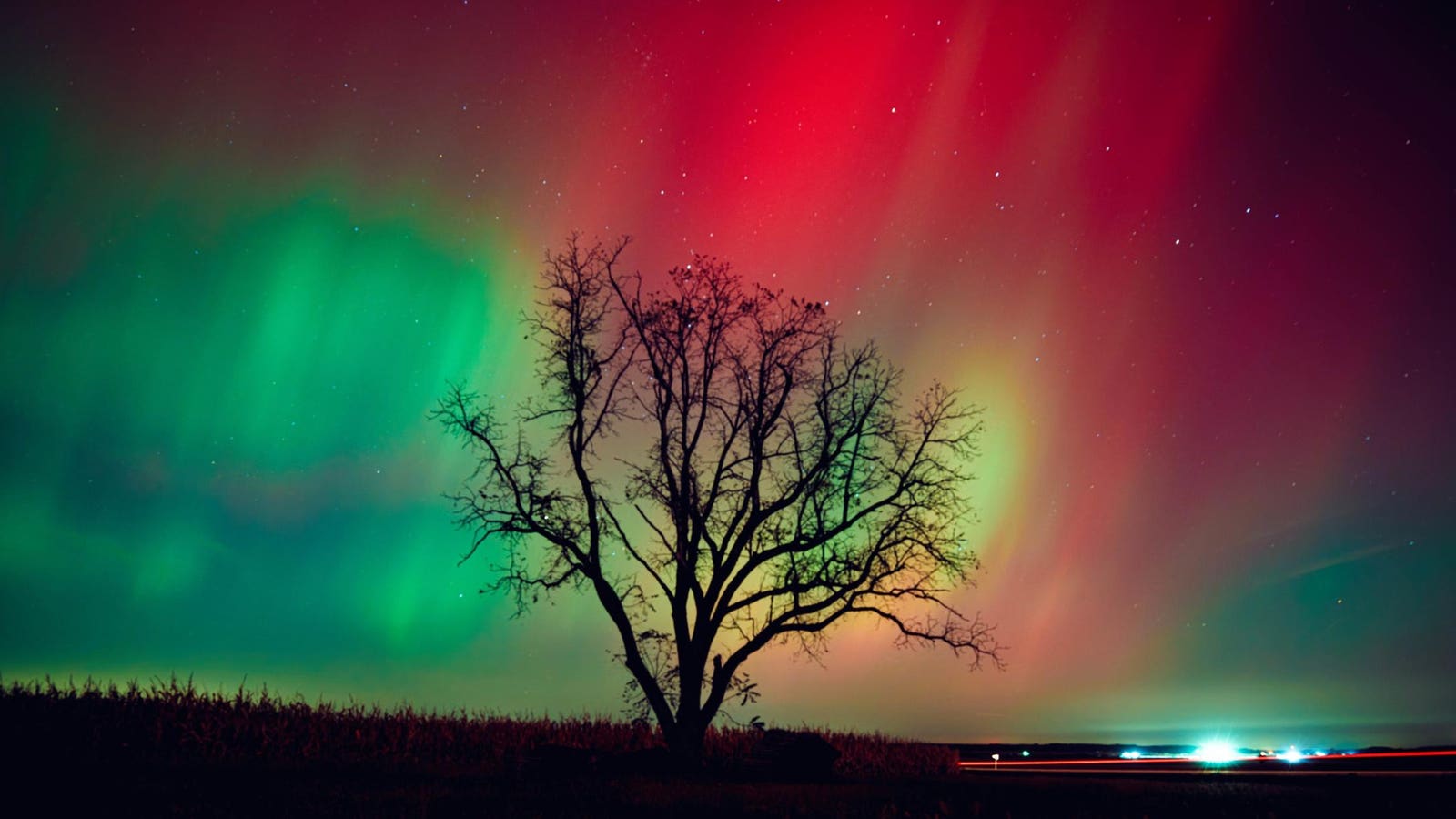Topline
The Northern Lights may ramp up in intensity for the next 50 years as the sun potentially enters a new long-term phase of heightened activity, suggests a new study by solar scientists.
The night sky in Wisconsin glows with the Northern Lights as a geomagnetic storm brings vibrant pink … More and green colors to a majority of the northern states. (Photo by Ross Harried/NurPhoto via Getty Images)
Key Facts
The sun has a solar cycle lasting roughly 11 years, during which its magnetic intensity waxes and wanes. It’s presently close to solar maximum, the peak of that cycle.
A paper published in Space Weather found that the sun may be on the cusp of entering a multi-decade period of intensity called the Centennial Gleissberg Cycle. A repeating longer-term pattern in solar activity, the CGC is a theoretical variation in the intensity of solar cycles over a century or so.
It’s possible that the last three solar cycles occurred during the CGC’s minimum period, with the following three set to occur during its maximum. That could mean solar cycles over the next 50 years or so becoming more intense.
Understanding Proton Flux
The evidence for the CGC’s current period is based on a correlation between the 11-year solar cycle and high-energy protons in Earth’s inner radiation belt. Proton flux increases when solar activity decreases. Using two NOAA satellites, the scientists have seen a decline in proton flux during the recent uptick in solar activity, which correlates with the midpoint of the CGC. Until 2022, the proton flux had been increasing.
Not all solar scientists agree with this theory. Scott McIntosh at space weather company Lynker Space and formerly of the National Center for Atmospheric Research at CU Boulder, told Live Science that it’s “too early” to make conclusions about the CGC and that the new paper may overestimate its effects.
The South Atlantic Anomaly
The scientists looked at the proton flux above the South Atlantic Anomaly in the South Atlantic Ocean, where Earth’s magnetic shield is weakest. “The protons are clearly decreasing in measurements we obtained from NOAA’s Polar Operational Environmental Satellites,” lead author Kalvyn Adams, an astrophysics student at the University of Colorado, told SpaceWeather.com. Other evidence includes sunspot numbers — direct indicators of solar activity — now at their highest levels in over 20 years, signaling a more turbulent and energetic sun. The CGC could also explain why solar cycle 24 — which occurred between 2008 and 2019 — was the weakest for 100 years.
Aurora Activity Expected To Increase
While the paper focuses on proton flux, higher solar activity generally means more. and more intense, geomagnetic storms — an essential cause of spectacular displays of auroras. This new insight into the CGC could mean more opportunities for aurora sightings in mid-latitude regions, including in the U.S. and Europe.
Even if the CGS theory is wrong, expect more aurora. As the sun’s magnetic activity begins to wane from solar maximum, another landmark display of aurora could likely result. “This period of solar decline is marked by a decreasing number of sunspots, but not necessarily by fewer impacts, even after the solar maximum,” said Lisa Upton, co-chair of NASA and NOAA’s Solar Cycle 25 Prediction Panel, announcing the arrival of solar maximum in October 2024. The declining phase is notable for having extreme solar events.
Background
The Northern and South Lights (aurora borealis and australis) result from an interplay between the solar wind — a stream of charged particles constantly flowing from the sun — and Earth’s magnetic field. When energetic particles reach Earth, they enter the polar regions, colliding with atoms and molecules in the upper atmosphere, exciting them and releasing energy as green and red lights.
Further Reading
ForbesNorthern Lights Forecast: 11 States On Alert Exactly A Year After Epic DisplayBy Jamie Carter
ForbesWhy Last May’s Once-A-Century Northern Lights Could Soon Be RepeatedBy Jamie Carter
ForbesHow To Photograph The Northern Lights With A Smartphone And A CameraBy Jamie Carter












